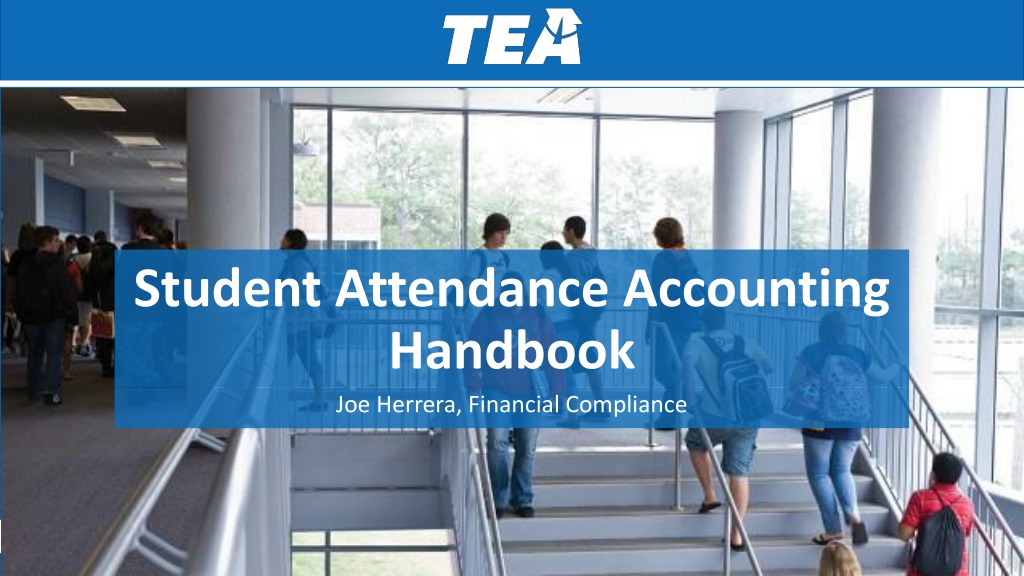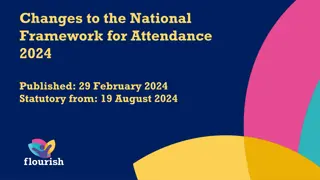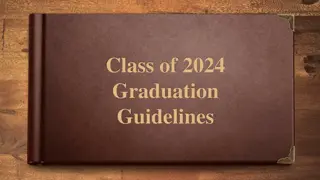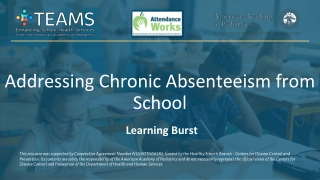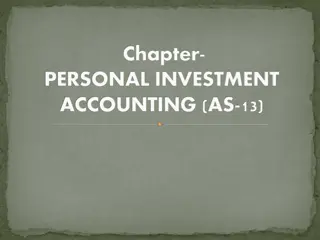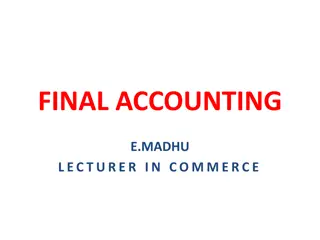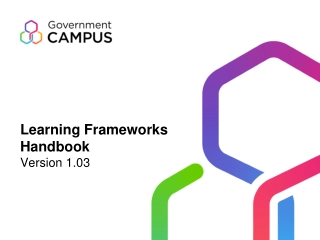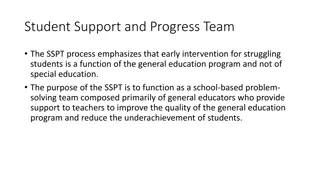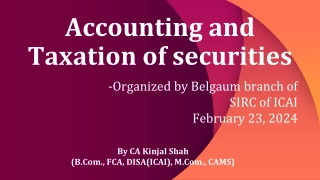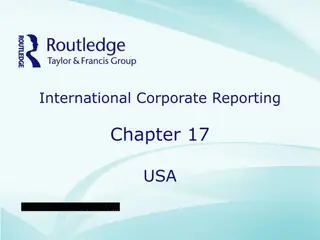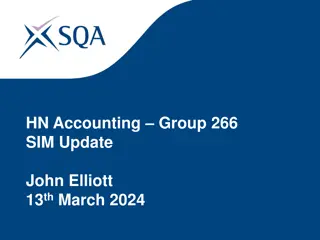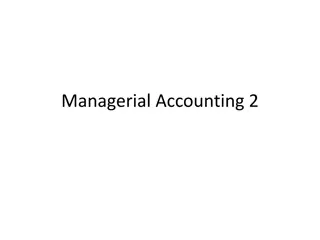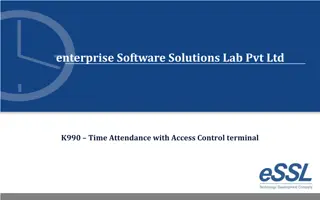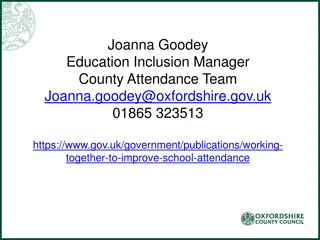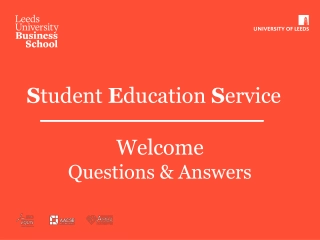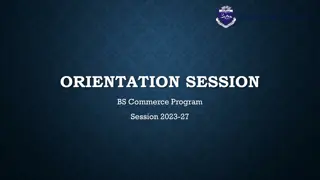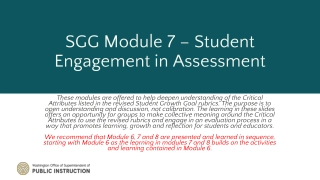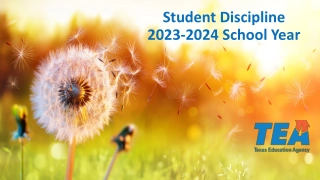Student Attendance Accounting Handbook Overview
The Student Attendance Accounting Handbook (SAAH) by Joe Herrera covers various sections outlining audit requirements, responsibilities, and guidelines for documenting attendance in educational settings. It provides information on topics such as prekindergarten, special education, career and technology programs, virtual learning, and more. The handbook also discusses proposed updates for the 2023-2024 academic year, including funding eligibility criteria and requirements for student attendance.
Download Presentation
Please find below an Image/Link to download the presentation.
The content on the website is provided AS IS for your information and personal use only. It may not be sold, licensed, or shared on other websites without obtaining consent from the author. Download presentation by click this link. If you encounter any issues during the download, it is possible that the publisher has removed the file from their server.
Presentation Transcript
Student Attendance Accounting Handbook Joe Herrera, Financial Compliance
SAAH: Why and How Statutory Citations Relating to Amendment to 19 TAC Chapter 129, Student Attendance, Subchapter AA, Commissioner's Rules, 129.1025, Adoption by Reference: Student Attendance Accounting Handbook
SAAH by Section: 1-13 1: Overview 7: Prekindergarten 2: Audit Requirements general, system, documentation 3: Attendance responsibilities, attendance taking, calendars 4: Special Education ECSE 5: Career and Technology (CTE) contact hours, documentation 6: Emergent Bilinguals/English Learners 8: Gifted/Talented 9: Pregnancy Related Services 10: AEP and Disciplinary Removals 11: Nontraditional Programs dual credit, OFSDP 12: Virtual Remote and Electronic Learning 13: Appendix
SAAH Section 3.2.1.1 ADA Code 0 a nonresident student who is charged tuition for the purposes of reducing local revenue local revenue
SAAH Section 3.2.2 Funding Eligibility Note: A student moved between instructional tracks cannot be counted present on the same day on each track for ADA.
SAAH Section 3.6.3 Requirements for a Student to Be Considered Present for FSP (Funding) Purposes Note: Documentation may be stored on paper or digitally but must be accessible for audit purposes regardless.
SAAH Section 3.7 General Education Homebound (GEH) Program Any student who is served through the GEH program must meet the following three criteria: The student is expected to be confined at home or hospital bedside for a minimum of four weeks. The weeks need not be consecutive. The student is confined at home or hospital bedside for medical or psychological reasons only. The student must have a current medical or psychological condition that is documented by a physician licensed to practice in the United States. Except in cases of medically fragile students, potential medical conditions or concerns that students may develop medical conditions do not constitute grounds for GEH program eligibility.
SAAH Section 3.7 General Education Homebound (GEH) Program - 2 A referral under Section 504 should be considered to determine eligibility for homebound students with a suspected disability. If the student is already eligible under Section 504, a Section 504 meeting must be held to discuss potential homebound eligibility.
SAAH Section 3.7.2 GEH Committee A designated campus committee must make decisions regarding GEH placement. For Section 504 eligible students, follow your Section 504 policies and procedures for committee membership. Members of the committee should include, but are not limited to: GEH/Section 504
SAAH Section 3.8.1.4 Low-Attendance Waivers An application for a low-attendance day waiver must be submitted using TEA s automated waiver application system, which is available in TEAL. Your district must include the following items in its application: documentation of low attendance for the day, including the reason for the low attendance rate, and the prior year s attendance report, showing the overall average attendance rate for the year for the district (if a waiver is requested for the district) or applicable campus (if a waiver is requested for a campus). For a district or campus with multiple tracks, the overall average attendance rate for all tracks must be used. For a new campus or a campus that existed as two separate campuses the prior year, the overall average attendance rate for the district as a whole must be used. These documents should be uploaded as attachments in the automated waiver application system.
SAAH Section 3.8.2 Closures for Bad Weather or Other Issues of Health or Safety Our school district or charter school closed all campuses for one day for a health or safety reason (for example, an ice storm made roads dangerous). Additionally, for charter schools: In the FSP System calendar, delete one makeup Ensure charter school s student attendance accounting software calendar is adjusted, per policy above, prior to generating and submitting the Six-Week District Summary Attendance report in the Foundation School Program System.
SAAH Section 4.3.3 Enrollment Procedures for a Student Who Is New to Your District but Was Previously Receiving Special Education Services When a student moves from one district to another within the state in the same school year and either the parents or previous district verifies that the student had an IEP that was in effect in the previous district, your district must meet the requirements of 34 CFR, 300.323, regarding the provision of special education services. Specifically, your district must provide a FAPE to the student, including services comparable to those described in the student s IEP from the previous district, until the ARD committee does either of the following: adopts the student s IEP from the previous district or develops, adopts, and implements a new IEP. The ARD committee s timeline for adopting the student s previous IEP or developing, adopting, and implementing a new IEP is 30 calendar days from the date the student is verified as being a student eligible for special education services. Verification means the new district has received a copy of the student s IEP that was in effect in the previous district.
SAAH Section 4.3.3.2 Summer Enrollment Procedures A student with a disability who has an IEP in place from a previous in- or out-of-state school district and who registers in a new school district during the summer is not considered a transfer student for the purposes of 34 CFR, 300.323(e) or (f). For these students, if the parents or in- or out-of-state district verifies before the new school year begins that the student had an IEP that was in effect in the previous district, the new school district must implement the IEP from the previous school district in full on the first day of class of the new school year or must convene an ARD committee meeting during the summer to revise the student's IEP for implementation on the first day of class of the new school year. If the student s eligibility for special education and related services cannot be verified before the start of the new school year, then the timelines for a student who transfers during the school year from an in-state or out-of-state district described above will apply. If the new district wishes to convene an ARD meeting to consider revision to the student s IEP before the beginning of the school year, the new district must determine whether the parent will agree to waive the five-school day notice. If the parent agrees, the new district must make every reasonable effort to hold the ARD meeting prior to the first day of the new school year. Verification means the new district has received a copy of the student s IEP that was in effect in the previous district.
SAAH Section 4.7.2 Code 01 Homebound To be placed in the special education homebound instructional setting, a student aged six years or older must meet the following four criteria: The student is eligible for special education and related services as determined by an ARD committee. The student is expected to be confined at home or hospital bedside for a minimum of four weeks. The weeks need not be consecutive if the student is chronically ill and the local district policy allows for such. The student is confined at home or hospital bedside for medical or psychological reasons only . The student must have a medical or psychological condition that is documented by a physician licensed to practice in the United States.
SAAH Section 5.3 Enrollment Procedures: If CTE courses are added or dropped, the student s CTE V- code could change. Changes will occur most often at the beginning of a new semester. If an LEA operates on a block schedule, CTE staff members may need to review student schedules more often, depending on the type of block schedule. Appropriate staff members need to review students schedules as courses are added or dropped. revenue
SAAH Section 5.5 CTE (Contact Hour) Codes Each CTE course must be reviewed separately to determine the average minutes per day students attend that course. To receive CTE weighted funding, course periods are required to be a minimum of 45 minutes in length for a total of 8,100 minutes per school year. In a 10 school day period. Three contact hours (V3) is the maximum an LEA may claim for a single course.
SAAH Section 5.5 CTE (Contact Hour) Codes - 2 Note: Auditing of a CTE course (that is, attending the course but not taking it for state graduation credit) is not considered CTE participation for purposes of TSDS PEIMS reporting. A student who is only auditing a CTE course, and taking no other CTE courses for state graduation credit, should not have CTE eligible days present on the 42401 Special Programs Reporting Period Attendance Extension.
SAAH Section 5.5.1 (Referring to Operating a Block Schedule) Each CTE course must be reviewed separately to determine the average minutes per day students attend that course. over a 10 day school period. Average minutes per day must be computed by reviewing a complete cycle of courses. For example, if a course meets on even numbered days of the month, LEA personnel must review a two-week cycle. (One week, the course will meet on Monday, Wednesday, and Friday, and the next week, the course will meet on Tuesday and Thursday.) LEA personnel divide the total number of CTE minutes for the course, for a complete cycle of courses, by the total number of school days during the cycle. To receive CTE weighted funding, course periods are required to be a minimum of 45 minutes in length for a total of 8,100 minutes per school year.
SAAH Section 5.6 Computing Contact Hours No matter what CTE V-code is assigned to a CTE course, LEA personnel must record the total number of eligible days present for the student in that CTE course with the course s V-code for each six-week reporting period in the Student Detail Report. When computing the Campus Summary Report (2.3.2 Campus Summary Reports), LEA personnel must determine the CTE V-code to assign to a student s CTE course separately based on the CTE course s average minutes per eligible school day. over a 10 school day period. (See the chart in 5.5. CTE (Contact Hour) Codes.) LEA personnel multiply the number of eligible days present for each student in each CTE course code by the corresponding V-code contact hour multiplier to derive contact hours. Each CTE V-code has a different contact hour multiplier.
SAAH Section 5.6 Computing Contact Hours - 2 Note: Eligible CTE days are the number of student instructional days in an LEA s calendar. The number of eligible CTE days varies among districts. Report contact hours by student ID and each individual CTE course ID.
SAAH Section 5.10 Documentation documentation showing the average minutes per day for each CTE course (minimum of 45 minutes per class period and minimum of 8,100 minutes per school year), such as a course calendar; and
SAAH Section 5.12 Examples CTE Examples
SAAH Section 6 Bilingual/English as a Second Language (ESL) As a result of Senate Bill 2066 in the 2021 legislative session, the term emergent bilingual student replaces the term limited English proficient (LEP) student used in the TEC, Chapter 29, Subchapter B. This also resulted in a change to the term English learner (EL) used in 19 TAC Chapter 89, Subchapter BB. These terms describe the same group of Texas students. An emergent bilingual student is in the process of acquiring English and has another language as the student's primary or home language. In PEIMS, the terms emergent bilingual (EB) and English learner (EL) are bridged as EB/EL, and the data element names may still indicate the use of LEP in some places during the transition. It is important to note that English learner is still used in federal regulations and guidance.
SAAH Section 6 Bilingual/English as a Second Language (ESL) - 2 Within this section, the term "parent" includes the parent or legal guardian of the student in accordance with the TEC, 29.052. Also, the term district includes all school districts, public, open- enrollment charter schools, and districts of innovation.
SAAH Section 6.2 Identification of EB Students and Enrollment Procedures Important: A student will be identified as emergent bilingual if the student t sis not English proficient ability in English is so limited or the student s disabilities are so severe that the English language proficiency assessment cannot be administered (19 TAC 89.1226(g)).
SAAH Section 6.2 Identification of EB Students and Enrollment Procedures - 2 The language proficiency assessment committee (LPAC) convenes to identify the student as emergent bilingual or as English proficient, based on the results of the English language proficiency assessment, and recommends placement of the identified emergent bilingual student in either the bilingual or ESL education program, in accordance with 19 TAC 89.1205 (a) and (c). However, district personnel do not yet assign the student a bilingual or ESL program type code in the attendance accounting system until parental consent is received.
SAAH Section 6 6.5 Program Services: Eligibility for State Bilingual Education Allotment (BEA) Funding 6.6 Program Services: Teacher Certification Requirements 6.8 Reclassification Criteria and Exit Procedures 6.10.2 Other Required Documentation
SAAH Section 9 Pregnancy-Related Services (PRS) Your district may choose to offer a PRS program. If your district chooses to offer a PRS program, the district must offer CEHI services as part of that program. Your district may offer CEHI only or both CEHI and other support services. However, your district must not code any student as PRS in the attendance accounting system unless CEHI is one of the services provided by the district s PRS program. Note: Students may also be eligible for Section 504 services (regardless of your LEA having a PRS program) due to a suspected disability relating to pregnancy such as having gestational diabetes. In this case, a referral to Section 504 would be required.
SAAH: 11.5.1 ADSY Program Design Additionally, LEAs are eligible for up to five days of ADSY waivers for missed instructional days throughout the year outside of the missed school day waiver system. These waivers will apply solely to meet the ADSY 180 day requirement. LEAs will need to submit evidence of a board-approved 180 day calendar in fall of each year in order to be eligible for the ADSY waivers. ADSY waivers should be submitted through the traditional waiver system and marked as Other .
SAAH: 13 Glossary Career Cluster One of the 14 Career Clusters around which CTE is organized. Further information can be found at http://tea.texas.gov/cte/.
SAAH: 13 Glossary - 2 migratory child - The term migratory child means a child or youth who made a qualifying move in the preceding 36 months 1. as a migratory agricultural worker or a migratory fisher; or 2. with, or to join, a parent or spouse who is a migratory agricultural worker or a migratory fisher.
SAAH: 13 Glossary - 3 military (member of uniformed services) (definition applicable for Interstate Compact on Educational Opportunity for Military Children) Retired and activity duty uniformed member of the active uniformed service of the United States, including members of the National Guard and Reserve on active duty orders or retired. Uniformed services means the Army, Navy, Air Force, Marine Corps, Coast Guard, the NOAA Commissioned Corps, and the Public Health Services Commissioned Corps.
SAAH: 13 Glossary - 4 original entry date The initial date that a student is physically or virtually present at the official attendance time. Original entry dates apply to both regular school and special programs.
Public Comment Changes Questions?
SAAH Staff Joe Herrera (512) 463-7708 joe.herrera@tea.texas.gov Padmaja Pija Sathyanarayan (512) 475-2012 padmaja.sathyanarayan@tea.texas.gov Attendance@tea.texas.gov Student Attendance Accounting Handbook | Texas Education Agency
\ ][poiytreq Questions? Thank you! Public Comment Changes
